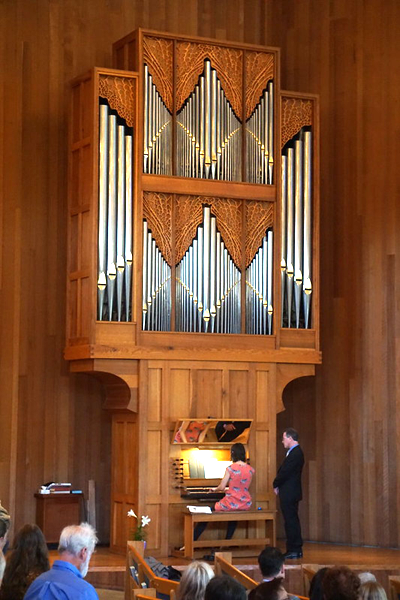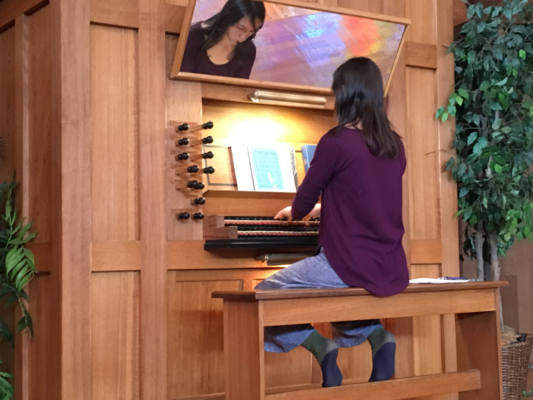 Organs have long provided music for religious events, offering composers the vehicle for some of their most provocative utterances. Over the centuries, organ builders have responded readily as forms of worship, artistic tastes, and musical styles have developed in many ways, in many countries. As a result, the term “organ” in our day actually describes a family of instruments that have obvious and important elements in common, but which at the same time show far-reaching differences.Since the 1960s, a small but growing group of American organ builders has striven to create organs that focus stylistically on a single historical type of instrument. Such organs illuminate the literature of the chosen style and two or three closely related styles with breathtaking effect, far better than an organ that attempts to embrace all styles. Such focused organs also accommodate music of many other styles with rare beauty and character, if perhaps not with authenticity.
Organs have long provided music for religious events, offering composers the vehicle for some of their most provocative utterances. Over the centuries, organ builders have responded readily as forms of worship, artistic tastes, and musical styles have developed in many ways, in many countries. As a result, the term “organ” in our day actually describes a family of instruments that have obvious and important elements in common, but which at the same time show far-reaching differences.Since the 1960s, a small but growing group of American organ builders has striven to create organs that focus stylistically on a single historical type of instrument. Such organs illuminate the literature of the chosen style and two or three closely related styles with breathtaking effect, far better than an organ that attempts to embrace all styles. Such focused organs also accommodate music of many other styles with rare beauty and character, if perhaps not with authenticity.
In 1972 St John’s decided not to move its 1957 Æolian-Skinner to its new sanctuary. Instead, it turned to John Brombaugh, one of the pioneers among that group of builders and perhaps its most influential craftsman. In early 1979 St John’s became the home of Mr Brombaugh’s Opus 20, one of three organs built by him at the same time, from the same plans, and with nearly identical stop lists. (The others went to Tacoma WA and Storrs CT).
Opus 20 comprises 31 ranks, 22 stops, and 1418 pipes. Its musical and structural design reflects principles of organ building that prevailed in the Protestant countries of northern Europe during the 150 years that ended with the death of J. S. Bach. It presents much music from other times and places well, too, although differently from how the composers probably imagined. And one need attend only one service at St John’s to know the power it brings to congregational singing.
The size, dimensions, and positioning of the keyboards and pedalboard resemble those familiar to 17th-century Dutch organists. The slider wind chests use a suspended mechanical (“tracker”) key action and a mechanical stop action. Tracker action provides an especially smooth attack of wind to each pipe, which permits gentler and more responsive voicing than electrical actions allow.
As a result, organists truly can play “on” the organ and control its response with their fingers; they no longer need to content themselves merely with operating the organ by electrical remote control. (Do any classical musicians other than organists settle for communicating with their instruments by telegraph?)Today, most organ builders tune their instruments in equal temperament, which leaves all keys a little out of tune. Our ears have adjusted, so we do not usually find the poor intonation disturbing. Keyboard instrument builders have routinely used equal temperament only since the early 19th century, however, and organ builders adopted it last. For Opus 20, Mr Brombaugh devised an elastic temperament based on Kirnberger III (Johann Philipp Kirnberger studied organ with J. S. Bach). All composers of organ music before the death of Bach unquestionably wrote for instruments tuned in an elastic temperament, or in some version of the older meantone temperament.
In the most commonly used keys, an elastic temperament makes music sound more in tune than it sounds in equal temperament. As keys acquire chromatics, however, the music sounds increasingly out of tune. (Not surprisingly, up through Bach’s day composers used the complex keys only for special effects in organ music.) An elastic temperament actually gives each key a unique character because of the way the subtle variations in intonation appear at different places in the scale of each key. Music played on an instrument tuned in an elastic temperament acquires a dimension of harmonic color that musicians took for granted 300 years ago, but which has totally disappeared with equal temperament.
 The wind pressure in St John’s organ displaces a column of water in “J”-shaped tube by 81 millimeters (3.19 inches); the electric blower and single-fold hinged bellows supply a flow of air whose pressure fluctuates slightly in response to such variables as the number of stops in use and the fullness of the musical texture. While such wind flexibility has disappeared entirely in organs with modern bellows systems, all pre-19th century organs evidently had it to some extent, to judge from the continual debate during the 17th and 18th centuries about acceptable levels of flexibility. The organist who plays an instrument with flexible wind must refine his or her playing technique in response to factors that simply do not arise with a modern system. As a result, both the player and the listeners experience musical nuances that pre-19th century musicians accepted as routine, but which modern systems obliterate.
The wind pressure in St John’s organ displaces a column of water in “J”-shaped tube by 81 millimeters (3.19 inches); the electric blower and single-fold hinged bellows supply a flow of air whose pressure fluctuates slightly in response to such variables as the number of stops in use and the fullness of the musical texture. While such wind flexibility has disappeared entirely in organs with modern bellows systems, all pre-19th century organs evidently had it to some extent, to judge from the continual debate during the 17th and 18th centuries about acceptable levels of flexibility. The organist who plays an instrument with flexible wind must refine his or her playing technique in response to factors that simply do not arise with a modern system. As a result, both the player and the listeners experience musical nuances that pre-19th century musicians accepted as routine, but which modern systems obliterate.
The wooden case, the façade pipes, and the pipe shades blend and project the sound the way a stereo console blends the sounds of the several speakers it contains, in contrast to the unfocused sound of unencased organs whose pipes may be scattered over an entire wall. The organ also stands in the same room as the listeners, as any indoor instrument should, but unlike organs of the early- and mid-20th century, which organ builders and architects often banished to an adjoining room (the organ “chamber”), and which spoke through wall openings. An organ in chambers usually sounds muffled, or requires loud and harsh voicing to make its sound loud enough to fill the room.The lowest eight notes of the Subbass in the pedal division of St John’s organ stand behind the case, and are made from alder wood. The case and the façade contain all the remaining pipes, made of a high-lead alloy that includes tin, antimony, copper, and bismuth, following ideas incorporated in 1540 by Hendrik Niehoff into his instrument for Schoonhoven, The Netherlands. The lower wind chest, spanning the entire width and depth of the case, holds the Great and Pedal divisions. The narrower and shallower upper chest holds the Positive (the upper manual). The case is made of hand-planed white oak which has been darkened with strong ammonia fumes to accelerate what is accomplished by natural aging. The upper back and side panels are of western red cedar, a stable wood with lively acoustical properties.
The pipe mouths and key nosings are gilded with 23 carat gold leaf. The pipe shades are carved Alaskan yellow cedar backed by western red cedar. The naturals of the keyboards are plated with cow shin bones. The sharps and stop knobs are of African ebony. The key cheeks are made from zebrawood, the pedal sharps from Brazilian rosewood, the pedal naturals and the stop rods from maple, and the black strip in the music rack from an oak dredged from a North German peat bog where it had soaked for many centuries. The keyboards and trackers are from sugar pine. The wind chests are from white oak, western red cedar, sugar pine, and sheep and cow leather. The reed shallots and tongues are of brass and some shallots are covered with lead plates and leather.
- Text by David R. Hunsberger and John Brombaugh

(56 notes)
1. Præstant 8
2. Octave 4
3. Octave 2
4. Mixture (III-V) 1
5. Quintadena 16 (lowest C-E, F# from # 20)
6. Holpijp 8
7. Spitzflöte 4
8. Nasard/Tierce 2 2/3 half draw . . . 2 2/3 + 1 3/5 full draw
9. Trumpet 8
10. Vox Humana 8 Positive (56 notes)
11. Præstant 4
12. Sesquialter (II) 1 1/3
13. Scharff (III) 1/2
14. Gedackt 8
15. Rohrflöte 4
16. Cigarflute 2
17. Dulcian 8
(30 notes)
18. Octave 8 (lowest 12 notes from # 1)
19. Octave 4 (lowest 6 notes from # 2)
20. Subbass 16 (highest 18 notes from # 6)
21. Posaune 16
22. Trumpet 8 (all notes from # 9)
Couplers:
P/I P/II I/II Tremulant
